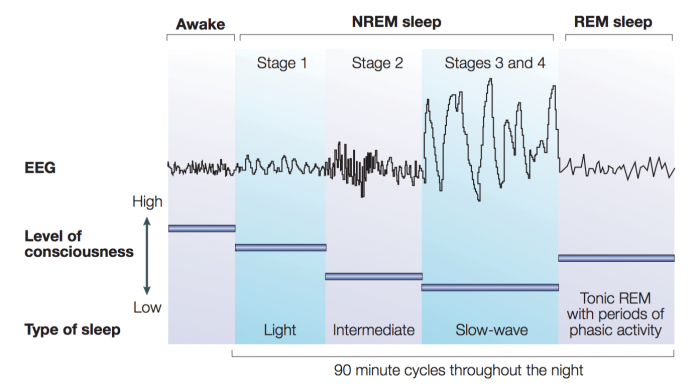Sleep and the EEG
When the EEG, or electroencephalogram, was invented, a whole new world opened for exploration — the previously unknown world we all enter when we fall asleep.
Before the EEG, sleep was often thought of as a death-like experience, wherein one loses consciousness each night, hopefully to return in the morning. Ancient philosophers grappled with it, lacking any way to measure sleep objectively. Aristotle described sleep as a “seizure of the primary sense organ”. Our remembered dreams gave us glimpses of this other world, often comprised of bizarre fantasies and sometimes disturbing nightmares, but no one knew for sure what was going on.
By measuring electrical activity in the brain, the EEG gave us a much better understanding of this unknown world. The brain – powered by billions of neurons, or brain cells – produces measurable waves of electricity the EEG can record. The first recording EEG machine was invented by German physiologist and psychiatrist Hans Berger in 1924.
Yet it would be almost 30 years later before scientists got the bright idea of attaching one of those devices to someone while asleep. In 1953, two researchers at the University of Chicago, Eugene Aserinsky and Nathaniel Kleitman, first measured the alternating periods of REM and NREM during all-night EEG recordings, launching the era of modern sleep research.
Now, many decades later, the EEG still remains a primary tool for laboratory sleep evaluation, and what researchers find looks something like this:

Psychiatry Reference - PsychDB
EEG recordings for various stages of sleep. Notice the similarity between REM sleep (right) and an awakened state (left), and the striking difference between that and the slow rhythmic waves of Stages 3 and 4, the deepest forms of sleep.
Stage 1, or drowsiness, begins to show theta waves indicative of sleep. True sleep starts in Stage 2 with the appearance of the sleep spindles and K complexes, and the deepest form of NREM shows regular rhythmic waves of electrical activity slowly sweeping across the brain.
Research has shown during the deepest slow wave sleep stages – when the brain both clears itself of toxins and replenishes its energy supply for a new day – these regular cycles of electricity literally draw cerebrospinal fluid into and through the brain to facilitate this cleansing and renewal process.
If awakened during a deep NREM stage, we usually remember little about our dreams and are typically very groggy. In complete contrast, the REM dream stage is much closer to a fully awakened state. In REM our dreams are vivid, and by completing one’s final REM stage of the night one likely feels better rested and more emotionally restored for a new day.
Sleep researchers have also found some remarkable consistencies with REM sleep across a number of different mammal species. At the human equivalent of between 2 and 3 years of age, the amount of REM sleep begins to drop significantly, replaced by more NREM sleep.
This suggests a major change in the purpose of sleep as we age. The research indicates the primary function of sleep for newborns to about age 2.5 is focused on brain growth and development. Thereafter, significantly more NREM corresponds to sleep being used more for brain maintenance and clearing of toxins.
The research also suggests the surge in REM typically experienced during puberty corresponds with the growth of the brain’s prefrontal cortex, usually associated with the development of higher thinking skills.
Use of the EEG opened a much broader understanding of sleep, with intense research still ongoing today. There is still much more that we don’t know than we know about this hidden world we enter each night.